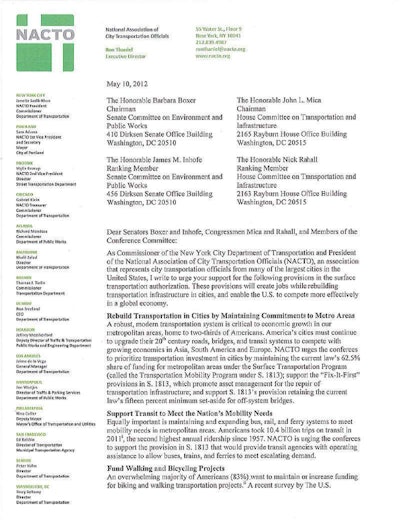Inside the highway and bridge industries
WISH LISTS
What our governors and others want in a reauthorization bill
Any surface transportation reauthorization bill will give state, regional and local agencies a bigger say — to what degree and with what caveats/catches is still uncertain — in using transportation infrastructure dollars from Washington. Even an underfunded, too-short bill with a pipeline attached will do that much.
But the legislation will also come from Washington. So just what is it that states themselves want in any new legislation? A letter from the National Governors’ Association to the House/Senate conference committee trying to work out a bill, gives us key clues.
Flexibility: Governors support maximum program and funding flexibility given the diversity of geography, population, and priorities in the states. They want a bill that preserves states’ authority to transfer funds between core federal-aid programs. “We urge conferees to preserve transferability at not less than 50 percent under current law, and oppose provisions that would limit transferability to less than this percentage,” they write.
Certainty: The governors are worried about the Highway Trust Fund (HTF). States, they point out, need federal funding stability and certainty to pursue long-term planning and project delivery. But while recent authorizations have kept the “funding firewalls” for HTF revenues and re-affirmed the user-pays principle, the Senate version of the bill does not preserve the HTF firewall. The governors want it in. “We also support preserving the historical 80-20 split between highway and public transportation spending.”
Financing: “Governors are concerned that proposals governing public-private partnerships would limit state flexibility to use this tool by chilling investor interest,” they write. They oppose the possible extension of the depreciation period to 45 years from 15 years for applicable highway property and related intangibles, “such as the cost of the grant to collect tolls, subject to a long-term lease held by a private entity, and the proposed prohibition against using private activity bonds to finance applicable leased highway property.” The governors also frown on the possibility that certain privatized toll lanes might be excluded from the calculation of a state’s National Highway System apportionment, but concede the need to avoid federal subsidization of private operators.
The governors also write that they support:
• the proposed expansion of and improvements to the Transportation Infrastructure Finance and Innovation (TIFIA) program. “We support extending through July 2013 the temporary increase in the ‘small issuer’ exception (from $10 million to $30 million in annual issuance) to interest-expense allocation rules for banks that purchase tax-exempt bonds.”
• excluding tax-exempt private activity bonds issued before January 1, 2013, from the Alternative Minimum Tax.
• allowing state infrastructure banks the option to issue Transportation Regional Infrastructure Project (TRIPs) tax credit bonds.
• excluding bonds issued through 2017 for sewage and water supply facilities from the cap on private activity bonds.
Reforming and restructuring federal transportation programs gets gubernatorial support, provided core federal programs are untouched and reforms avoid any requirements that could preempt state flexibility. “We support provisions to streamline project delivery that reduce approval and completion times and improve efficiencies, but also achieve the intent underlying critical environmental, planning and design, and procurement reviews.”
There is support for outcome-oriented performance measures as an opportunity for “intergovernmental partnership, not top-down mandates.” But, they say, “states, not the federal government, should establish specific performance targets that track national goals, and that performance metrics must be clear, measurable, customer-focused, and attainable.”
More Pressure
At the same time another letter reached the committee, this one from a broad umbrella group of transportation organizations, lobby groups, think tanks and advocates. This epistle pushed the committee to “expand the flexibility and capacity of states and localities to address their transportation infrastructure investment challenges.” The group also asks the conferees to do all they could to allow state and local bodies “to introduce tolling and user-charge systems.”
The group is adamant that state and local bodies should be able to raise transportation infrastructure funding pretty much any way they can. Their letter requests, “the elimination of federal barriers to state and metropolitan flexibility and innovation, in raising investment capital and in generating revenues.”
The group is worried that provisions in the Senate version of the bill might dissuade agencies from trying to raise private funds for fear of losing some of their federal money. And those same provisions, they say, “would also eliminate the option to use private activity bonds (PABs) to finance leased highway projects and would substantially lengthen depreciation timetables for long-term highway leases, making them less attractive to investors.” The letter argues that while a bill must protect the public interest, these provisions, “do not respect the ability of states and localities to make such determinations of the public interest on behalf of their citizens.”
The private group wants states to handle their own transportation infrastructure investment problems. “Old obstacles should be dismantled, and no new barriers should be erected. If states and metropolitan regions are going to be asked to do more in transportation, and if more of the funding and investment responsibilities are to devolve to them, it is essential that this legislation remove the restrictions to their capacity to innovate.”
To see the wish list sent to the conference committee by the National Association of City Transportation Officials go to our digital edition, page 7a


SAY WHAT?
“This is America. We’ve always had the best infrastructure.”
– President Barack Obama












